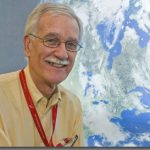Description
Not every scientist can boast about putting an end to Biblical-level plagues. But NASA Senior Earth Scientist Compton Tucker helped to end periodic locust swarms which pop up in dry parts of the world and go onto wreak havoc on subsistence crops in places where communities can’t afford to lose food. He did this by doing what he does best – studying the Earth using satellite data. In the case of locusts, it meant watching for areas where the occasional wet period ushers in large quantities of the insects. But his techniques can also be used to monitor food productivity or estimating how much carbon is sequestered by growing vegetation.While Tucker’s technique for measuring vegetation levels in a given area may have ended up in space, it started out with him walking around with a walkie-talkie sized device held together with rubber bands and masking tape. The senior Earth scientist at NASA would walk around the landscape with arm stretched out in front of him in the late 1970s around Beltsville, Md. calling out readings to whoever he could voluntarily enlist during this early research. He would eventually take his device all over the Earth – places like Iceland, Scotland, Wales, Sweden and Sothern France before the technology ended up on satellites. (Recorded 10 December 2018)
Participants
-
Compton Tucker
-
Josh Learn
-
AGU Narratives


